Have you ever thought about diving Cancun cenotes while in the Riviera Maya? The stunning Kukulkan Cenote is a 33 feet (10 meters) deep blue cavern that is part of the Chac Mool caving system in Yucatan, Mexico. It is set in a jungle scenery with fresh and saltwater, lots of fossils, and even a few stalactites.
Cancun Cenotes and Riviera Maya Cenotes
The main attraction though is the unbelievable beams of light piercing the water and creating somewhat of a laser show through the water. I totally enjoyed taking underwater photographs of the Kukulkan cenote. This caving system is also known as Cancun Cenotes or Riviera Maya Cenotes because of its proximity to both places. All I know is that I love diving cenotes, especially Kukulkan!
✦ Cancun Cenotes: What are Cenotes?
Cenotes are basically like underground natural swimming pools. They are formed by the collapse of the limestone rock that makes up the peninsula along the Riviera Maya in Mexico. The land (limestone rock) is porous and over time they let natural river water in, as well as seawater from the ocean. When the limestone rocks give way, cenotes become an underworld of groundwater swimming holes! Most cave cenotes have fresh water from the rivers of the mountains and then saltwater that seeps in from the ocean.
 ✦ There Are Thousands of Cancun Cenotes in Mexico
✦ There Are Thousands of Cancun Cenotes in Mexico
There are literally thousands (6000) Cancun or Riviera Maya cenotes found in the Yucatan of Mexico. Even I was shocked to realize there are that many cenotes in the area. Many are more like swimming holes where families go swimming, snorkeling, and just to relax. Other caves have extensive areas for scuba diving in these underground caverns. Each one, though, is unique with different shapes, depths, and types of water in each one.
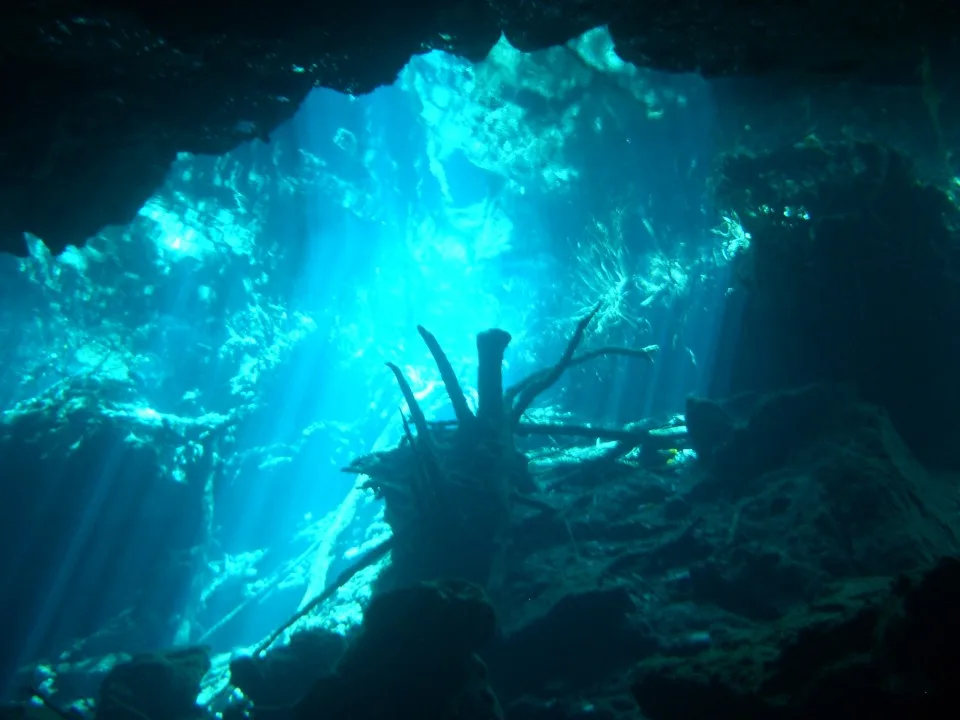 ✦ How to Find a Cenote in Mexico
✦ How to Find a Cenote in Mexico
You can reach the Cancun cenotes on a well-worn, dirt road, that lately has become a very popular destination for first-time cave diver experience. First-time divers will have an abundance of sunlight in the cave and the passages are wide enough to get tanks through with no problem. Many Cancun diving and diving Playa shops bring divers out here all the time, so choose your dive shop carefully. They will most likely have you meet them at their shop in Cancun or you will be picked up from your hotel, depending on where you are staying.
✦ Diving in Cancun Cenotes
We met our dive guide at the Cancun Diving shop at the crack of dawn to get a good spot. Wide-eyed and bushy-tailed, we arrived after about half an hour’s drive down the freeway. We then turned off on some dusty road to what looked to be some guy’s dilapidated old house. He pulled the run-down, tiny pickup truck with our gear loaded in the back into where the front yard should be and then turned off the engine.
I thought we were there to buy breakfast burritos or for him to pick up a friend, as this certainly couldn’t be the place. Off he goes without saying a word into the neglected shack with a slam of the door. We sat in silence, as we anxiously looked around when I suddenly spied a skinny chicken coming from around the corner. As it turned out, this was the entryway into the sacred lands of the cenote Mexico and our guide had gone into the entrance building to pay the fee! After all, this is Mexico, I shouldn’t be surprised. Eventually, he returned, and yells “Buena Suerte”– Wishing us to have “good luck!”
As the first arrivals at the faded old house (entrance), we had beat the other early-rising divers and were able to park the truck in the parking spot closest to the entrance of the Kukulkan Cancun Cenote. We would be the first ones to enter into the cave system down below. Shortly thereafter, other divers began to arrive.
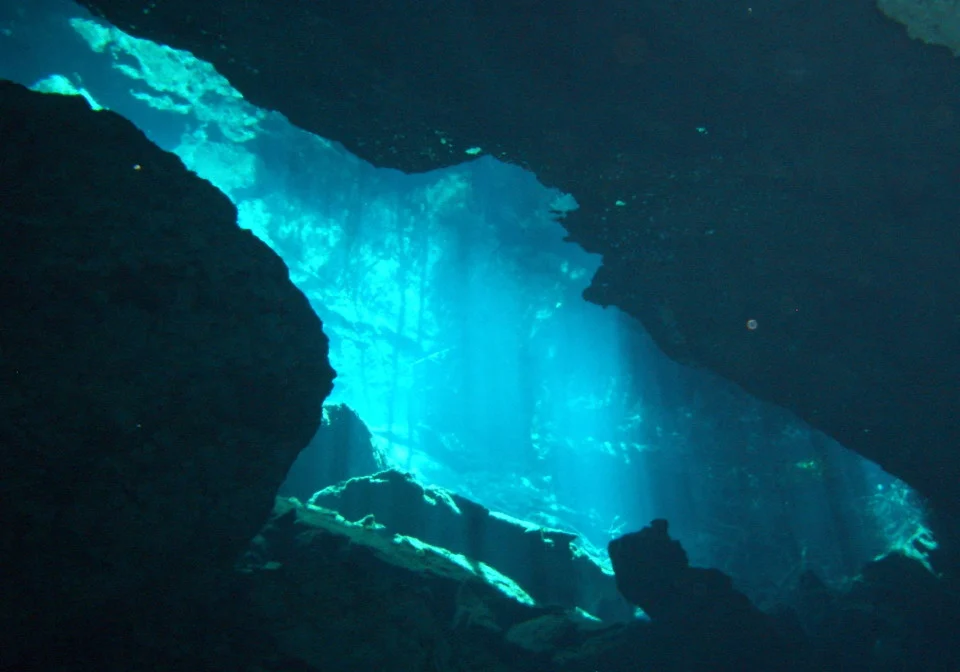 ✦ Diving the Cenote Cancun Cave Known As Kukulkan
✦ Diving the Cenote Cancun Cave Known As Kukulkan
We are geared up and I can’t for the life of me figure out where the heck the water is! It looks like we are in a jungle with lush trees and brush everywhere. “Who the heck could have found this place?” I am wondering. Loaded down with my wetsuit, tank, BC (buoyancy compressor), mask, fins, and booties, I start walking only about 10 feet from where we geared up to see a cemented staircase to the underground.
We walk down a few steps and there it is: This beautiful, crystal-clear turquoise water, which is the entryway to the Kukulkan Cenote through a beautiful pond of freshwater. We are excited to go in and scared at the same time!
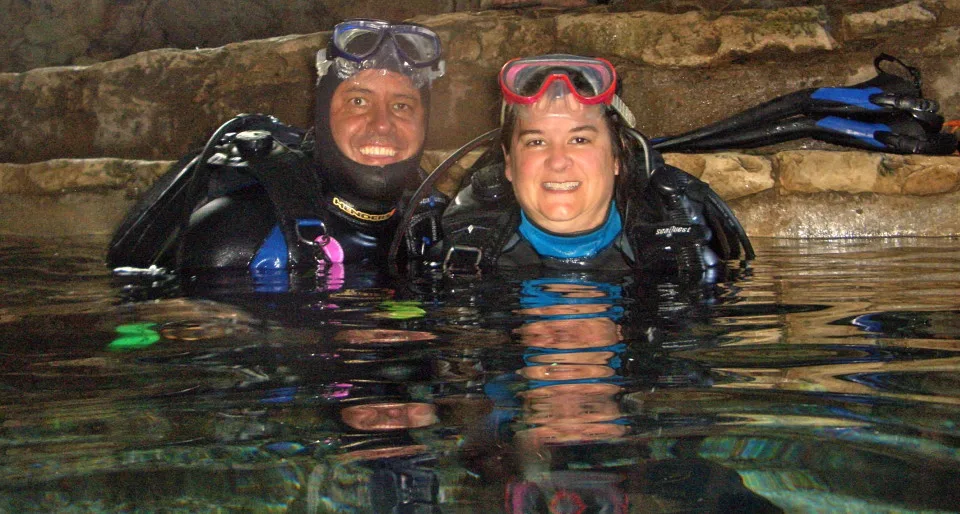 Diving Cenote Kukulkan, Yucatan Mexico
Diving Cenote Kukulkan, Yucatan Mexico
Cenote Kukulkan is an underwater cavern system in the Yucatan area of Mexico, also known as the Riviera Maya Cenote. Cenote Cancun’s entrance is only a couple of hundred feet away from the Cenote Chac-Mool, which is 100 meters south of Puerto Aventuras.
Map of Riviera Maya Cenotes
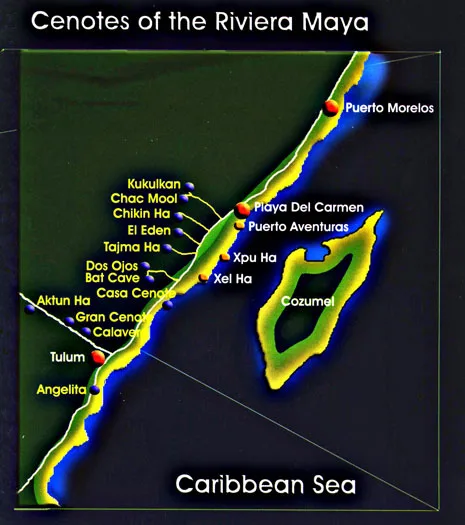
Map of the cenotes of the Riviera Maya, Yucatan, Mexico
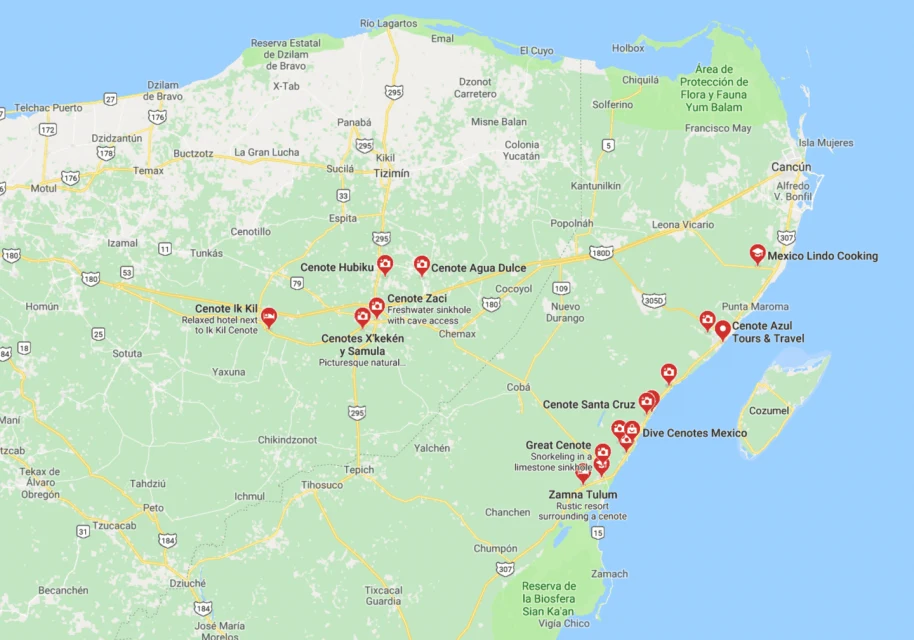
Map of Cenotes Riviera Maya
Related: 13 Best Cenotes to Visit near Tulum
✦ What to Expect When Diving Cenotes in Mexico:
At approximately 10 meters (almost 33 feet), you will be entering the halocline zone, which I call the “oil and vinegar” zone. The halocline is the interface of freshwater and saltwater when these waters mix they produce zero visibility. If you shine your light at the point where the salt and fresh water meet, you can marvel at the reflections projected onto the walls of the cavern.
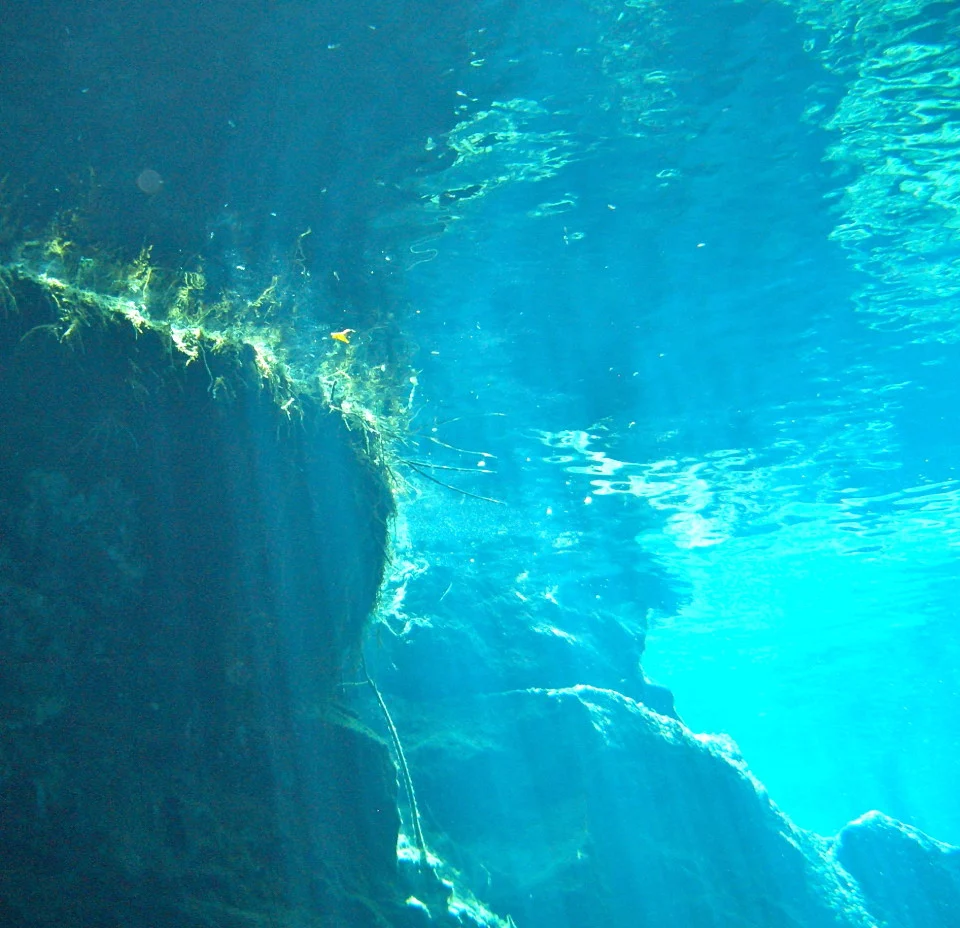 The light effects are amazing, as sunlight penetrates the darkness. Here, as you look towards the ceiling at the entrance, you can also see the colors of the rainbow.
The light effects are amazing, as sunlight penetrates the darkness. Here, as you look towards the ceiling at the entrance, you can also see the colors of the rainbow.
 ✦ Cenotes Riviera Maya Diving
✦ Cenotes Riviera Maya Diving
The Riviera Maya lies along the Caribbean coastline of Mexico. This region of Mexico is known for its high level of tourism and beautiful villages. The Riviera Maya is home to Playa del Carmen, Tulum, Puerto Aventuras and many other areas. In almost every area of this region, there are all-inclusive resorts, lovely restaurants, beaches, and notable cenotes. Cave diving and swimming are the main activities to enjoy on a Riviera Maya cenote.
The underground river system is open to the ocean, while freshwater from the mainland flows out into the ocean, then saltwater from the sea also creeps inland to the cenotes. Since saltwater is denser than freshwater, you can see the layers of the water, which by the way, makes it almost impossible to see through while you are diving. Just the areas where the two intermixes are the part where you can’t see anything, you can see above the layers of water and below the layers of water, but not in that “mixed” area. (Reminds me of mixing oil and water during a science experiment).
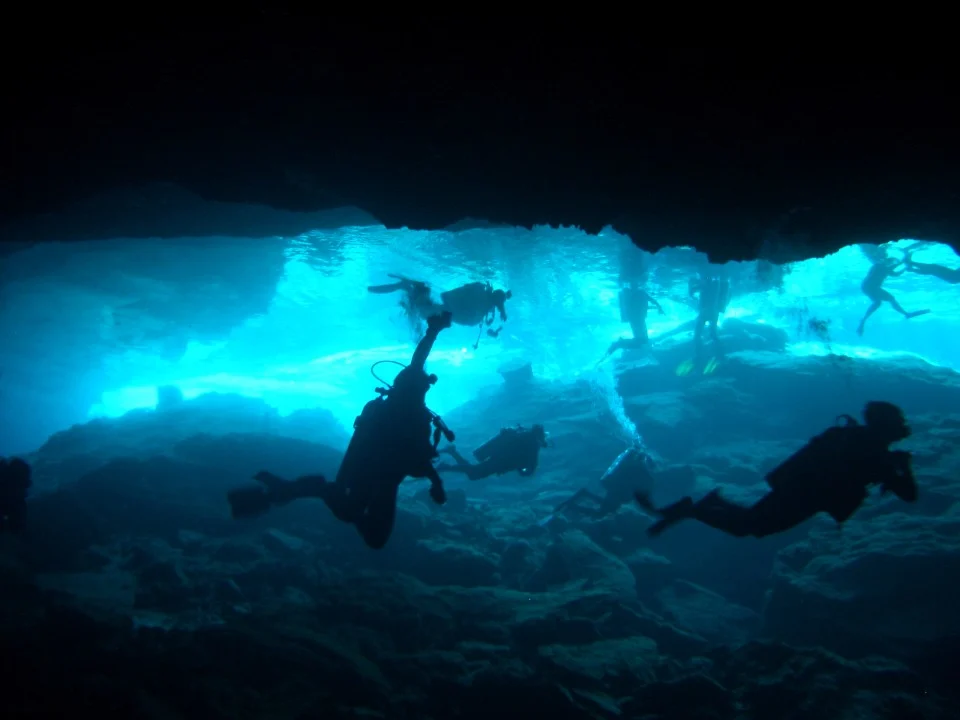 One of the interesting properties of saltwater is how it absorbs and transmits light. Divers descending into the saltwater portion of the Cenote Cancun, you will notice that the saltwater has a sparkling blue quality. Rays of sunlight filtering down through the saltwater lose their red tones, and the surface appears a rich cobalt blue. It is very cool to observe this interesting light effect.
One of the interesting properties of saltwater is how it absorbs and transmits light. Divers descending into the saltwater portion of the Cenote Cancun, you will notice that the saltwater has a sparkling blue quality. Rays of sunlight filtering down through the saltwater lose their red tones, and the surface appears a rich cobalt blue. It is very cool to observe this interesting light effect.
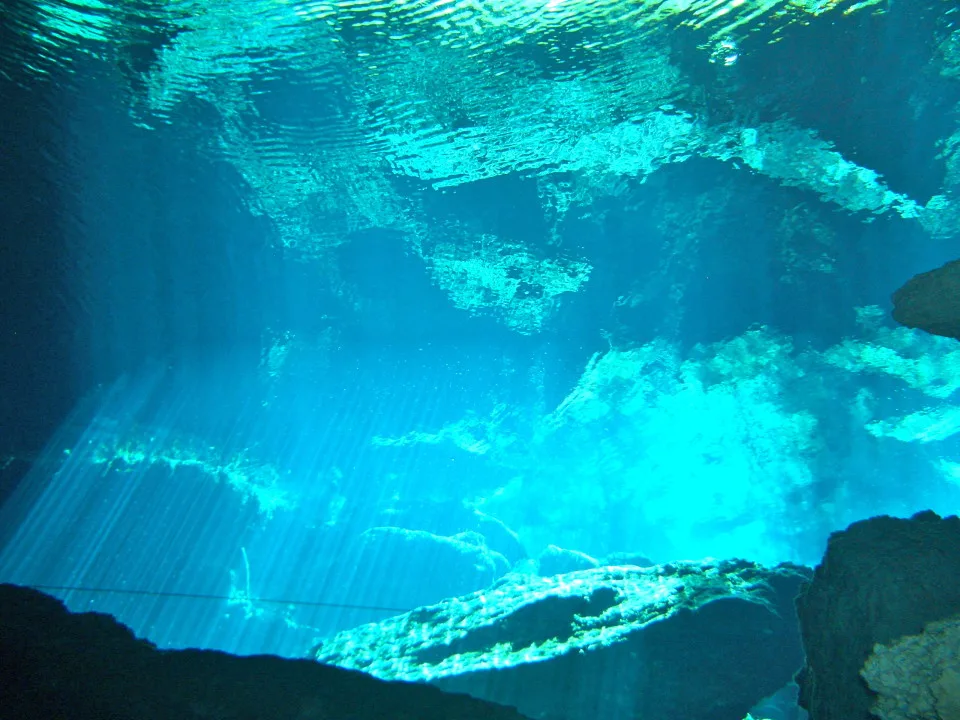 What are Cenotes?
What are Cenotes?
A cenote, mentioned before, is similar to a cave or sinkhole and almost all cenotes contain water. There are four different types of cenotes such as an open, cave, semi-open and underground. The Riviera Maya in Mexico has thousands of cenotes and no two are the same. Cave cenotes are the youngest type of cenotes. These cenotes are perfect for adventure seekers who get a thrill by heading closer to the Earth’s surface. These caves are known for the stunning green and blue colors of the water.
The semi-open cenotes are not as young as the caves but still contain unexposed elements. The semi-open cenotes are known for their relaxing nature and beautiful underwater flora and fauna. Open cenotes are the second oldest cenotes and are known for their natural beauty. Over thousands of years, the walls of these cenotes collapsed which led these cenotes to open wide up. The oldest Riviera Maya cenotes are the ancient cenotes. These are similar to a lake or lagoon and contain no rock formations.
Science Lessons Diving Cenote Cancun
Most of the cenotes in Mexico have limestone and rock formations. As you continue reading you will come across the terms: stalactites and stalagmites. These words are commonly used to describe the formation and minerals of the cenotes. According. a stalactite is an icicle-shaped formation that is made from calcium carbonate. These deposits are more likely to be found hanging from cave cenotes. A stalagmite is also made of calcium carbonate and is found on the floor of a cave, similar to an introverted stalactite. This is a cool thing to notice while you are diving.
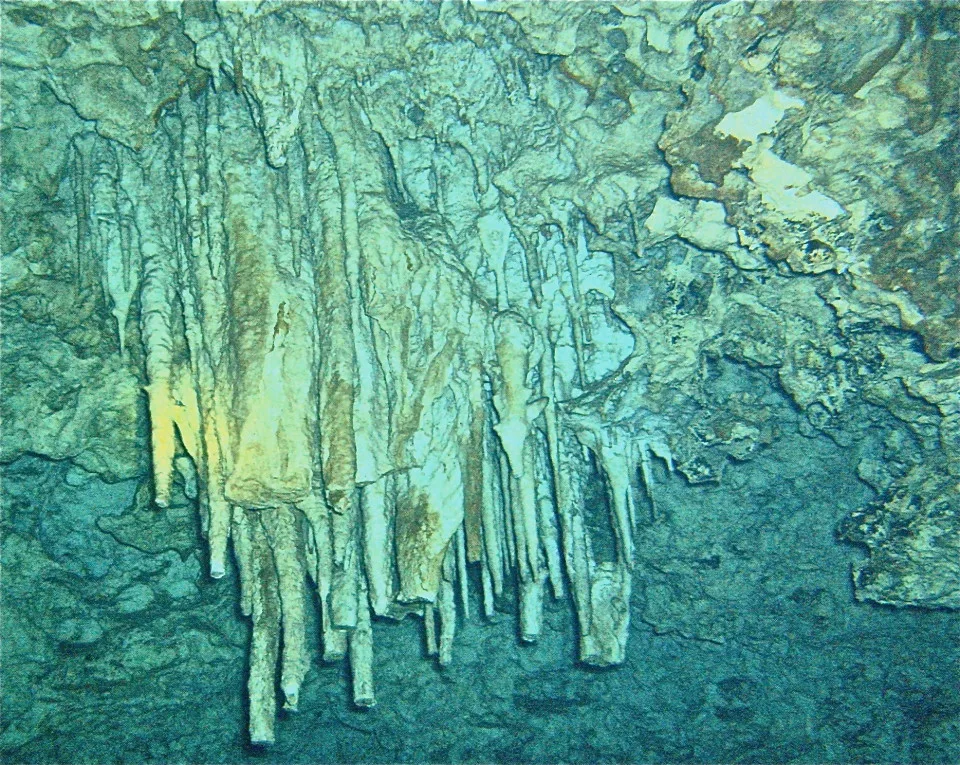 They grow in pairs or groups, the slightly acidic water dissolves some of the limestone carrying it downward. When the water evaporates, the limestone appears to have flowed downward. Some of the water does not evaporate until it has fallen through the air and landed on the floor while the remaining limestone builds the stalagmite.
They grow in pairs or groups, the slightly acidic water dissolves some of the limestone carrying it downward. When the water evaporates, the limestone appears to have flowed downward. Some of the water does not evaporate until it has fallen through the air and landed on the floor while the remaining limestone builds the stalagmite.
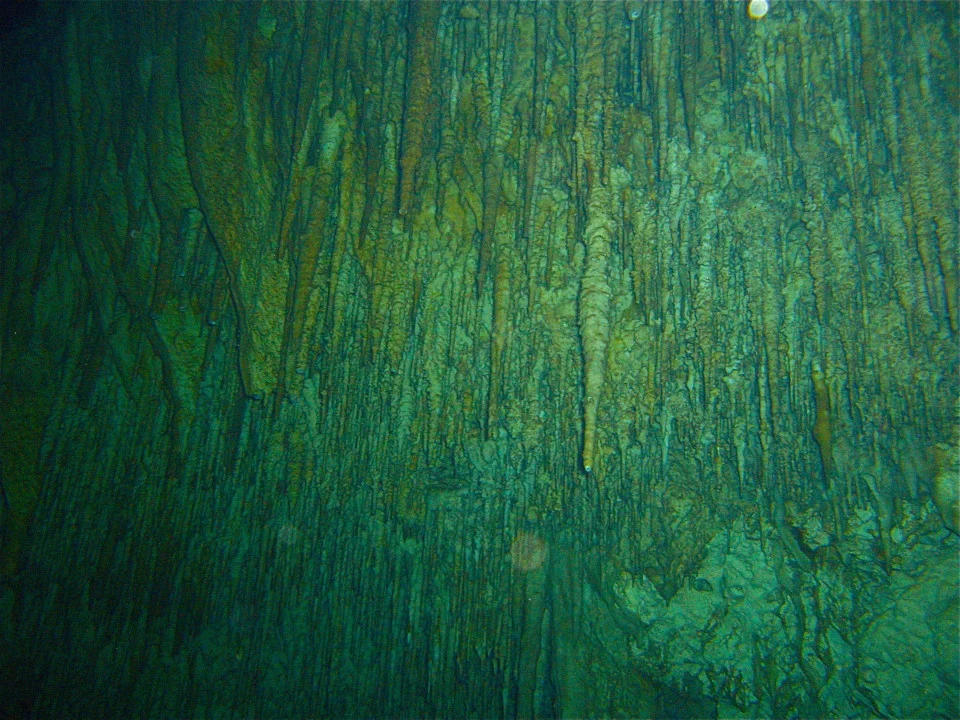 The Yucatan Mexico peninsula is basically a giant limestone slab that was once a coral reef. For millions of years, rainwater carved the porous stone, creating these beautiful caves. This Yucatan Mexico peninsula is penetrated with miles and miles of cave systems, which is great for the Cancun diving shops, as they have plenty of places to dive!
The Yucatan Mexico peninsula is basically a giant limestone slab that was once a coral reef. For millions of years, rainwater carved the porous stone, creating these beautiful caves. This Yucatan Mexico peninsula is penetrated with miles and miles of cave systems, which is great for the Cancun diving shops, as they have plenty of places to dive!
The Ancient Mayans had a deep connection with the cenotes and believed they were the entrance to the underworld. The Ancient Mayans also believed that the Mexican cenotes were created to celebrate life and death. In the past, many Mayan rituals were held at various cenotes throughout the Riviera Maya.
 List of Riviera Maya Cenotes:
List of Riviera Maya Cenotes:
Take a closer look at the list below of cenotes located in the Riviera Maya:
1. Cenote Azul
Admission Fee: 120 Pesos *
Hours of Operation: daily from 8:30 am- 5:30 pm **
The Cenote Azul is best known for its turquoise-colored waters, hence the name Azul (which means blue). This is an open cenote that allows visitors to swim freely in this lagoon-like cenote. Thanks to the shallow water, this cenote is perfect for families and young children to enjoy a swimming adventure. One of the fun parts of this cenote is getting a free “pedicure” as the little fish gently peck at your feet.
2. Cenote Calavera
Admission Fee: 100 Pesos (additional costs for diving and rentals)
Hours of Operation: open every day from 9 am-5 pm
A quick 10-minute drive from Tulum will allow you to reach the Cenote Calavera. From the entrance gates, you will need to walk for a couple of minutes along the rocky path to reach the cenote. Once you arrive at the cenote, you will find that it is literally a sinkhole. This sinkhole has a rope swing and a wooden ladder to reach the center of the cenote. Adventure seekers are sure to explode with excitement as they experience cliff jumping from this cenote.
3. Cenote Carwash
Admission Fee: 100 Pesos (prices may vary depending on your choice of swimmers, snorkelers, or divers.
Hours of Operation: Open daily from 8 am-6 pm
The Cenote Carwash, aka Aktun Ha, is one of the most beautiful caves in the Tulum area. Visitors of this cenote enjoy activities such as snorkeling, sunbathing, diving, and swimming. This cenote has large stalactites, plenty of fish, and freshwater turtles that swim around you. Visitors are allowed to have a picnic, so pack your cooler and relish in the beauty of this cenote.
4. Cenotes Casa Tortuga
Admission Fee: 600 Pesos (includes experience to all four cenotes and a guide)
Hours of Operation: daily from 9 am-5 pm
Each of the four cenotes at Casa Tortuga is uniquely splendid and wonderful to visit. Thanks to the variety of the cenotes, you can enjoy swimming without being stuck in crowds of people. I recommend touring the area with a guide to making your experience more memorable. A guide will take you to the cave cenotes Wisho and Campana and then the open cenotes, Tres Zapotes and Jaguar.
5. Cenote Chaak Tun
Admission Fee: 600 Pesos
Hours of Operation: daily from 9 am-3 pm
Divers love visiting the Cenote Chaak Tun because of the gorgeous underwater rock formations, stalagmite, and stone replica of the Virgin of Guadalupe. I will give you a fair warning, diving in this cenote is not for anyone who is claustrophobic. Guests prefer to tour the area and cenote with a local guide such as James or Ricardo, both of whom are very knowledgeable and friendly.
6. Cenote Dos Ojos
Admission Fee: 350 Pesos
Hours of Operation: 8 am- 5 pm
Cenote Dos Ojos (two eyes in Spanish) is one of the best underwater cenotes in Tulum. Thanks to its natural beauty and appearance in films (Journey into the Caves and The Cave (2006), this cenote has become increasingly popular in the last decade. To avoid the large crowds, I recommend visiting at the time of opening because the place usually fills up after 9:30 am. This cenote has a depth of 396 feet and a water temperature that reaches up to 70 degrees Fahrenheit. Visitors can rent life jackets, masks, snorkeling gear, and lockers.
7. Cenote Ik Kil
Admission Fee: 150 Pesos
Hours of Operation: 9 am – 5 pm
After exploring the ancient ruins of Chichen Itza, you must stop by the Cenote Ik Kil at the Ik Kil Archeological Park. This cenote has a large swimming hole with a depth of 130 ft. This semi-open cenote is surrounded by greenery and rock formation. Most people prefer not to dive 85ft into the cenote, so there is a stairway to take you down to the center of the cenote. Guests often stay at the nearby cottages and dine at the local restaurant to get the full experience of the Cenote Ik Kil.
8. Cenote Jardin del Eden, aka Ponderosa
Admission Fee: 200 Pesos
Hours of Operation: open Sunday to Friday, 9 am – 5 pm
The Cenote Jardin del Eden is another lovely cenote in Playa del Carmen, it is a great spot for snorkeling, diving, and swimming. Thanks to the preservation of the cenote, guests can tour the area and admire its natural state. This open cenote is surrounded by growing plants, lush trees, moss, and plenty of rock formations. Adventure seekers must go cliff diving from the 12-foot-high jump-off point into the center of the cenote. I recommend visiting this cenote during the week because on Sunday it can get very crowded.
9. Cenote Manati, aka Casa Cenote
Admission Fee: 120 Pesos
Hours of Operation: 8 am – 6 pm
The Cenote Manati is situated in the Tankah Bay and is accessible by public transportation, taxi, and even by renting a car. Guests can engage in activities such as swimming, kayaking, snorkeling, paddle boarding, and diving. When visiting the Tulum cenotes, I recommend booking a tour simple to Cenote Triple Adventure. A tour guide like this includes a trip to the Casa Cenote, Gran Cenote, and the Temple of Doom, plus a professional guide and snorkel gear.
10. Cenote Samula
Admission Fee: 80 Pesos
Hours of Operation: 8 am – 7 pm
On the outskirts of Valladolid is the Cenote Samula. This semi-open cenote has a natural skylight, shallow waters, and stunning stalactites. This cenote has stunning crystal-clear water, a small walkway and a stairway to access the center of the cenote. Make sure to snap loads of pictures to share your adventure with followers and friends!
11. Cenote Siete Bocas
Admission Fee: 300 Pesos
Hours of Operation: 8 am – 5 pm
The literal translation of this cenote is Seven Mouths and it was named to signify the 7 access points in which the light enters. This cenote is complete with restrooms, life jacket rentals, and a parking lot. I recommend wearing comfy shoes and bringing light snacks and water when visiting the Cenote Siete Bocas. I definitely recommend wearing a life jacket when cliff diving from the top of this cenote!
12. Cenote Suytun
Admission Fee: 120 Pesos
Hours of Operation: daily from 9 am – 6 pm
The Cenote Suytun is mainly closed with a small opening in the ceiling. One of the most instagrammable parts of this cenote is the sunbeams streaming down into the center of the cenote on the stone pier. Snorkeling and rental gear are available at this cenote. However, due to shallow water diving is not allowed.
13. Cenote Taj Mahal
Admission Fee: 120 Pesos
Hours of Operation: 9 am – 5 pm
One of the cenotes with a hidden depth is the Taj Mahal, aka Tajma Ha. This cenote is situated in Puerto Aventuras and it is a stunning place to visit. The beauty of this cenote is indescribable thanks to the underwater caverns, stalagmites, and stalactites. A diving adventure at this cenote is not for the claustrophobic as you will swim in a dark cave.
14. Cenote X’acel
Admission Fee: 100 Pesos
Hours of Operation: 9 am – 5 pm
Off the Highway of 307 lies the stunning area of X’acel. This area is well known for its stunning beach, with crystal clear water and white sand. Aside from one of the most beaches in the area, X’acel is known for its lovely cenote. The path to the cenote is a short walk along a wooden bridge. The cenote is open wide that is surrounded by large trees and a wooden platform. Visitors are always pleased to enjoy a beach day followed by a visit to the unique jungle-like cenote. Don’t forget to take tons of pictures of the fish and turtles!
15. Cenote X’Canche
Admission Fee: 70 Pesos
Hours of Operation: 8 am – 3:30 pm
In the dense jungle of the archaeological site of Ek Balam is the Cenote X’Canche. This cenote in Mexico is situated 30 minutes from Valladolid. Thanks to the Ek Balam archaeological site, visitors love to spend the day exploring the ancient ruins and then relaxing in the cool cenote. At this cenote, you can rent bicycles, go ziplining and rappelling. In my opinion, the best times to visit are before 11 am or after 2 pm. For additional fees, guests can rent lockers, showers, and changing rooms.
16. Gran Cenote
Admission Fee: 180 Pesos
Hours of Operation: 8 am – 4:45 pm
One of the most famous cenotes in the Riviera Maya is the Gran Cenote. This cenote has crystal clear water, accessible caves, and a jungle-like atmosphere. The caves are partially underwater and are surrounded by stalagmites and stalactites. Adults and children are sure to love swimming in the open cenote along with the turtles and fish. Divers and snorkelers are sure to get a kick out of exploring the underwater cave, complete with pillars and ladders. Visitors can rent lockers (to store personal items), rent snorkeling gear, and wash up at the washrooms.
*Admission fees were valid at the time of writing this article but are subject to change. Plus, I would recommend bringing cash with you because not all of the cenotes accept credit or debit cards.
**Hours of Operation are subject to change
✦ Cenote Diving: The Perfect Dive in Mexico
Cenotes usually offer the perfect dive conditions such as crystal clear water, almost current free, and the best visibility you could ever imagine. Not to mention that the water temperature is 77 °F all year long! All that sounds like a diver’s dream to me.
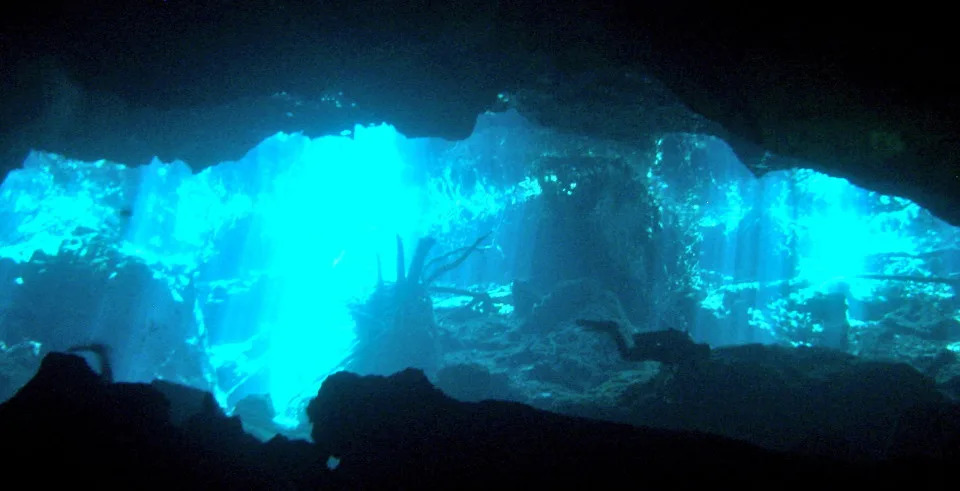 The whole thing seemed crazy to me at first, but I am always up for some adventure and now I believe it should be a “must” for every scuba diver, so put it on your bucket list! I loved it and would do it again in a heartbeat! I guess we really were lucky that day!
The whole thing seemed crazy to me at first, but I am always up for some adventure and now I believe it should be a “must” for every scuba diver, so put it on your bucket list! I loved it and would do it again in a heartbeat! I guess we really were lucky that day!
✦ Cancun Diving Stats
Diving Cenote Cancun, Yucatan Mexico
Level: easy
Max Depth: 50ft / 15m
Approx Dive Time: 40 min
Observe: light, fossils, halocline
✦ Safe Cenote Diving
I personally wouldn’t go into the caverns without a guide. These local guides in Mexico know the cave system, they know where to take you and know better than to take you into dangerous territory. The caverns they don’t want you in are clearly marked as “danger” (“Peligro”) and I would recommend abiding by these rules.
Too many times, divers think they know about diving, even though they don’t cave dive that much. I think it is imperative to listen to the local cave dive masters. Sorry for the blurry photo, but I was in that “oil and water” section of water where you can’t see very well and this photo is a good example of what it looks like!
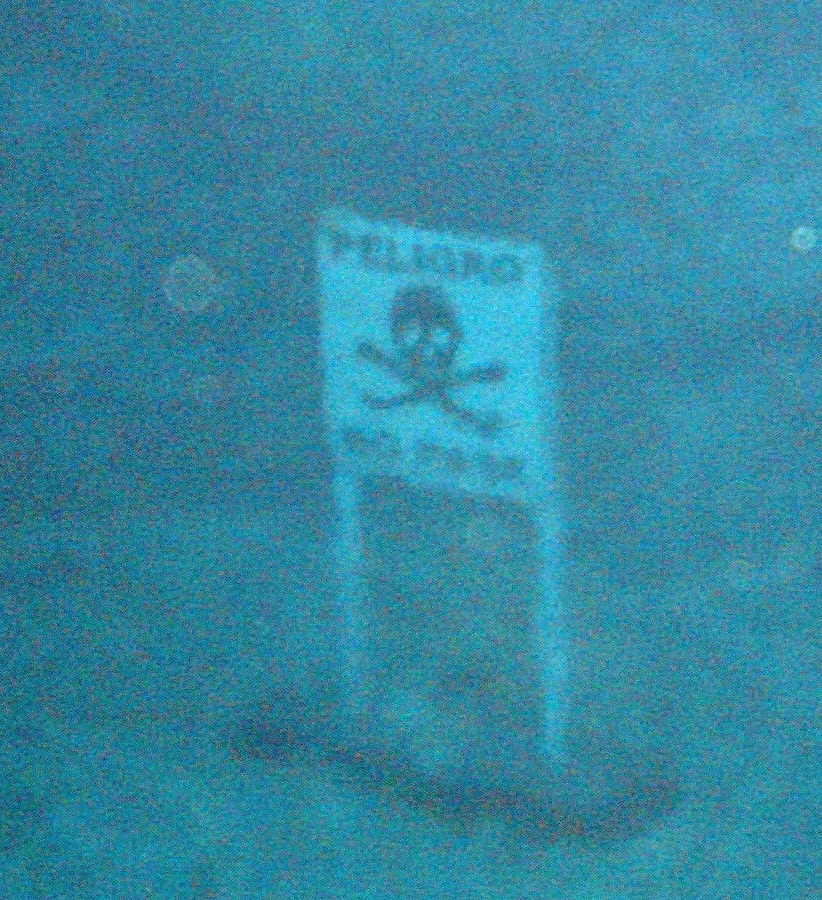 How many cenote dives have you been on? This was my first, and hopefully not my last cenote dive!
How many cenote dives have you been on? This was my first, and hopefully not my last cenote dive!
Recommended Reading
Here are a few other articles I wrote about diving:
Galapagos Scuba Diving at its Finest Hour!
Scuba Diving the Red Sea: Aqaba, Jordan العقبة
Scuba Diving in French Polynesia
Diving at Castaway Island, Fiji
The list above of Riviera Maya Cenotes only contains a handful of cenotes in Mexico. There are literally hundreds of cenotes spread out throughout Mexico. The Riviera Maya has some of the most beautiful cenotes in Mexico and it is a real pleasure to visit any one of them. A friendly reminder when visiting any type of cenote is to respect the environment and follow the rules posted on site. Simple rules such as: wearing a swimsuit, not using sunscreen or lotion, and rinsing before you enter the water, can help keep the cenotes clean and in prime condition. As long as you follow these easy rules then you can visit all the cenotes on this list and more!!


Liz
Thursday 29th of August 2013
Amazing amazing amazing!!! We have been talking about doing something like this down in Mexico later this year. But after reading this and seeing your pics, I'm sold! This looks like an incredible experience. Thank you so much for sharing!
Liz Www.peanutsorpretzels.com
Cacinda Maloney
Thursday 29th of August 2013
It is an absolute must for divers!! I loved it and would do it again in a heartbeat!
Jennifer
Friday 16th of August 2013
I so need to get dive certified! These photos are great! What kind of underwater camera setup are you using?
Cacinda Maloney
Friday 16th of August 2013
For these photos, I have an underwater casing for my Lumix ZMC 7, a point and shoot. It takes great underwater photos, as well as land photos.